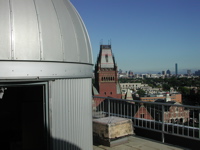|
Harvard University
Astronomy Lab and Clay Telescope
|
|
Day Labs | Evening Labs | Cloudy Day Labs | MaximDL Help
Measure Elevation and Azimuth of Jupiter and Aldebaran
This lab should serve as an introduction to the night sky. We will be observing 3 stars (Vega, Mizar, and Caph). The goal is to observe how these stars appear to move from hour to hour and week to week.
Positions of celestial objects on the sky are measured with two angles: i) azimuth, or the horizontal (in the plane of the ground) angle of the direction to an object vs. the direction to the North, and measured East of North; and ii) elevation, the angle between the object on the sky and the horizon directly below. Celestial positions are changing with time and so three measurements must be made: azimuth, elevation (azimuth and elevation are both in degrees) and time (date and time, to the nearest 30 seconds).
There will be 3 small Meade telescopes on the roof of the Science Center pointing at the above 3 stars. These telescopes have been aligned to the North Star, Polaris, so the azimuth angle is the number of degrees from True North. Azimuth angles can then range from 0 degrees (North), to 90 degrees (East), to 180 degrees (South), to 270 degrees (West) and then back to 360 degrees (North). Elevation, also referred to as altitude, angles will range from 0 degrees (on the horizon) to 90 degrees (on the zenith).
What you need:
- a red flashlight
- paper and pencil
- clock
Procedure:
- You should first visually locate all three stars in the night sky. Use the star chart (chart 1) to help guide you. Vega is in the "Summer Triangle" which is overhead in early evening in late September. Next, find the Big Dipper (Ursa Major) in the northwest. Mizar is the second from the end in the "handle" of the dipper. Finally, look for the "W" shaped group of stars, Casseiopeia, and locate Caph - the top star.
- We will take measurements of these three stars at the beginning and end of every observing session each night for a few weeks. Our small telescopes are not tracking the star so before we take measurements we need to make sure they are aligned in the reticle eyepiece. Using the table (pdf or docx), one person should record the elevation angle from the side knob of the telescope and the azimuth angle from the bottom of the telescope, while the other person records the accurate time off the clock.
- Notice that there are 24 numbers on the bottom (azimuth) dial. These refer to the hour angle (24 hours in one day). Since there are 360 degrees of azimuth, each number is 15 degrees. Use the fine divisions to measure azimuth to within (at least) 5 degrees.
- Every person in your group should fill in their own sheet. This means that every person should make a measurement and then estimate an uncertainty. You will then have 2-3 measurements per group if you pool your data at the end of the session.
- Be sure to take a measurement at the start of lab and at the end of lab. Try to take measurements as close to the same time every night, if possible.
Analysis:
- First, we will mark our star chart (chart 1) with a vector [small arrow] in the direction that the AZ, EL are changing over the one night's measurements. Starting at the star position, draw the arrow "up" if EL increased and "left" if AZ increased [and vice versa if either decreased]. This will show how your star is moving on a given night [the diurnal motion].
- Next, we will do the same for a star's weekly motion. Enter your data in the Excel template (template 1) and it will interpolate the data to a specific time. This will allow you to compare the same time a week apart even if you weren't able to observe at that exact time.
- Print a new sky chart (chart 1) and mark similar vectors for the same time but a week apart.
- From your several nights of measurements over several weeks as marked, deduce which way each of the 3 stars is moving on the sky and then describe the overall motion that all 3 of them represent.
- Finally, from comparing where a given star (e.g. Caph) is at the same time (e.g. 8pm) on each night, how are the stars "moving" from night to night?



